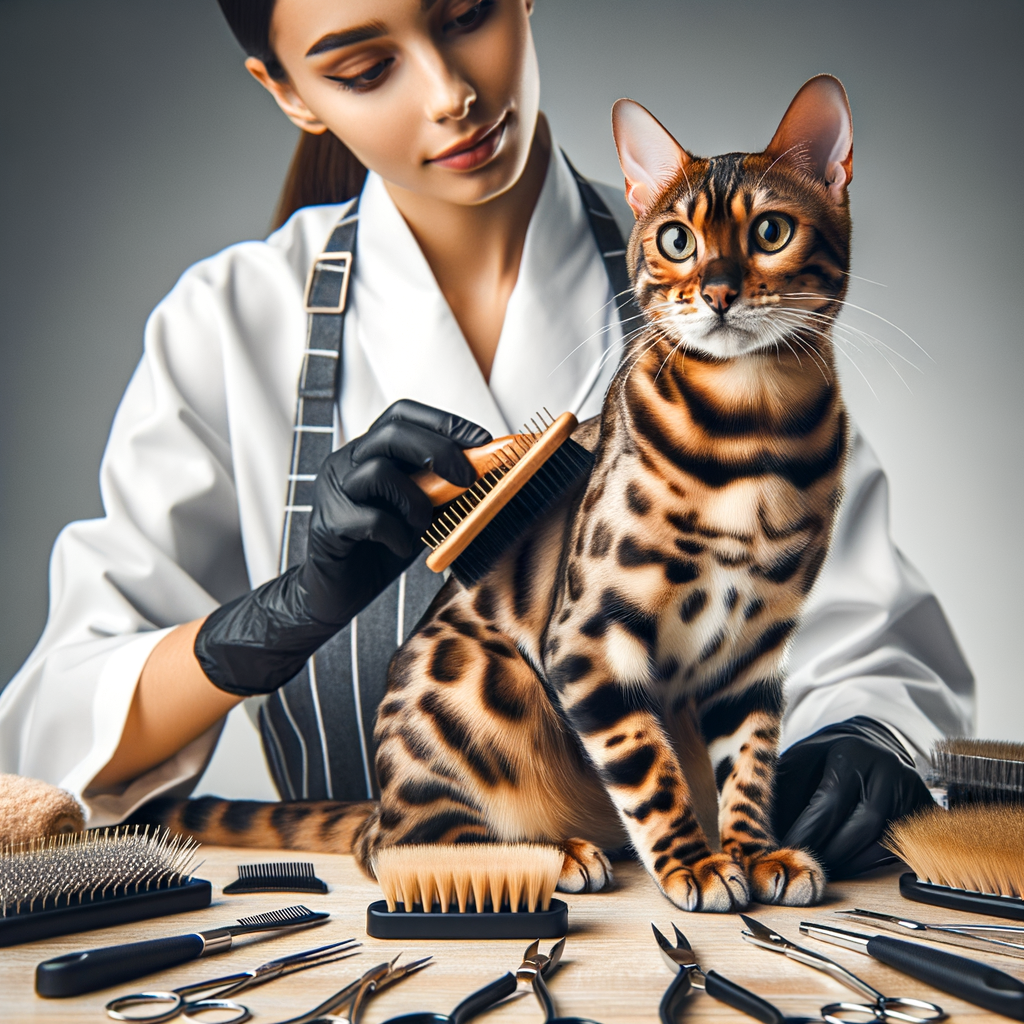
The Importance of Regular Grooming for Bengal Cats
Bengal Cats
- Characteristics of Bengal CatsBengal cats are known for their energetic and playful nature. They are highly intelligent and love to explore their surroundings. These cats are also very social and enjoy interacting with their human companions.
- Unique Features of Bengal Cat CoatsBengal cats have a distinctive coat that sets them apart from other breeds. Their fur is short, dense, and soft, often featuring beautiful spots or marbled patterns. The coat’s unique texture and appearance require regular grooming to keep it in top condition.
Why Regular Grooming is Essential for Bengal Cats
-
Health Benefits of Grooming Bengal Cats
Regular grooming helps keep Bengal cats healthy. It removes loose fur and dirt, which can prevent skin problems. Grooming also helps spot early signs of issues like fleas or ticks. According to Wikipedia, fleas can cause itching and even lead to infections.
Brushing your Bengal cat can also reduce hairballs. Hairballs form when cats ingest loose fur while grooming themselves. Regular brushing minimizes the amount of fur they swallow.
-
Maintaining Bengal Cat Hygiene
Regular grooming keeps their coat clean and shiny. It also helps remove dead skin cells and spread natural oils. These oils keep their fur soft and healthy.
Bathing your Bengal cat occasionally can also help maintain hygiene. Use cat-friendly shampoo to avoid skin irritation. Clean ears and trim nails during grooming sessions to keep your Bengal cat in top shape.
-
Bengal Cat Fur Maintenance
Bengal cats have unique fur that requires special care. Their coat is short but dense, with a beautiful pattern. Regular grooming helps maintain this stunning appearance.
Brushing your Bengal cat at least once a week can keep their fur in good condition. It prevents matting and tangling. Use a brush suitable for short-haired cats to avoid damaging their coat.
| Grooming Task | Frequency |
|---|---|
| Brushing | Once a week |
| Bathing | Once a month |
| Nail Trimming | Every 2-3 weeks |
| Ear Cleaning | Once a month |
Bengal Cat Grooming Tips
Establishing a Grooming Routine for Bengal Cats
- How to Groom a Bengal Cat: Start by brushing your Bengal cat’s coat. Use a soft brush to remove loose hair and prevent matting. Pay special attention to their belly and underarms, as these areas can get tangled easily. Next, clean their ears with a damp cloth and check for any signs of infection. Finally, brush their teeth with a cat-friendly toothpaste to keep their mouth healthy.
- Grooming Frequency for Bengal Cats: Bengal cats have short, sleek coats that don’t require daily grooming. However, brushing them once or twice a week can help reduce shedding and keep their coat shiny. Regular grooming also helps you spot any skin issues early. Aim to clean their ears and brush their teeth at least once a week.
| Grooming Task | Frequency |
|---|---|
| Brushing Coat | 1-2 times a week |
| Cleaning Ears | Once a week |
| Brushing Teeth | Once a week |
Best Grooming Tools for Bengal Cats
- Brushes and Combs:Brushing your Bengal cat helps remove loose fur and prevents matting. Use a slicker brush for best results. A comb with wide and narrow teeth can also help remove tangles.
- Shampoo and Conditioners:Choose a cat-specific shampoo that is gentle on their skin. Avoid human shampoos as they can be harsh. A conditioner can help keep their coat shiny and soft.
- Nail Clippers:Use a pair of cat nail clippers for safe and easy trimming. Be careful not to cut too close to the quick.
Case Studies: The Impact of Regular Grooming on Bengal Cats
Case Study 1: Improved Health and Hygiene
Regular grooming can make a big difference in the health and hygiene of Bengal cats. Let’s look at a real-life example.
Meet Luna: Luna is a 3-year-old Bengal cat. Her owner, Sarah, noticed that Luna was shedding a lot and had some mats in her fur. Sarah decided to start a regular grooming routine.
| Grooming Routine | Results |
|---|---|
| Brushing twice a week | Reduced shedding and fewer mats |
| Monthly baths | Cleaner coat and less dander |
| Regular ear cleaning | Fewer ear infections |
After a few months, Sarah saw big changes in Luna. Her coat was shinier and softer. Luna also seemed happier and more comfortable.
Regular grooming improved Luna’s health and hygiene. It also strengthened the bond between Luna and Sarah.
Case Study 2: Enhanced Coat Quality
Regular grooming can greatly improve the coat quality of Bengal cats. In this case study, we will look at how consistent grooming practices led to a shinier and healthier coat for a Bengal cat named Luna.
Background: Luna is a 3-year-old Bengal cat. Her owner noticed that her coat was becoming dull and rough. They decided to start a regular grooming routine to see if it would help.
Grooming Routine:
- Brushing: Twice a week with a soft-bristle brush.
- Bathing: Once a month with a cat-safe shampoo.
- Diet: High-quality cat food rich in omega-3 fatty acids.
After three months of this routine, Luna’s coat showed significant improvement.
| Before Grooming | After 3 Months of Grooming |
|---|---|
| Dull and rough coat | Shiny and smooth coat |
| Frequent shedding | Reduced shedding |
| Dry skin | Moisturized skin |
Key Insights:
- Regular brushing helps remove dead hair and distribute natural oils.
- Bathing with cat-safe shampoo can improve coat texture.
- A diet rich in omega-3 fatty acids supports skin and coat health.
According to Wikipedia, grooming is essential for maintaining a cat’s coat and overall health. Luna’s case shows that with consistent grooming, Bengal cats can have a beautiful and healthy coat.
Key Takeaways: Bengal Cat Grooming
- The Importance of Regular Grooming: It helps keep their coat clean and reduces shedding. Grooming also allows you to check for any skin issues or parasites.
- Effective Bengal Cat Grooming Tips: Brush your Bengal cat at least once a week. Use a comb to remove loose fur and prevent matting. Bathing is not usually necessary, but if you do, use a cat-friendly shampoo.
- Choosing the Right Grooming Tools: Select tools that are gentle on your cat’s skin. A slicker brush and a fine-tooth comb are good choices. Make sure to also have nail clippers and ear cleaning solutions handy.
| Grooming Aspect | Frequency | Tools Needed |
|---|---|---|
| Brushing | Weekly | Slicker brush, fine-tooth comb |
| Bathing | As needed | Cat-friendly shampoo |
| Nail Clipping | Monthly | Nail clippers |
| Ear Cleaning | Monthly | Ear cleaning solution |






